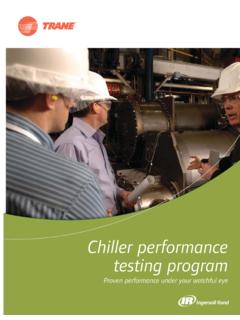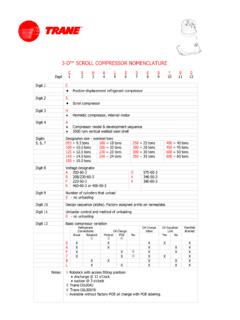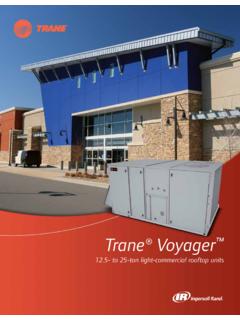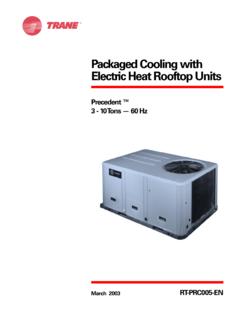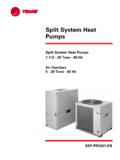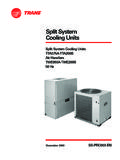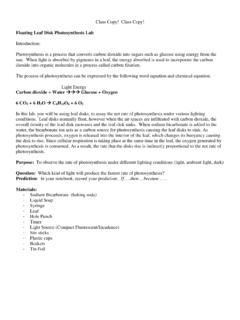Transcription of volume 48–3 Indoor Agriculture: HVAC System Design ...
1 Providing insights for today's hvac System designer Engineers Newsletter volume 48 3. Indoor Agriculture: HVAC System Design Considerations with epidermal cells on the top and Indoor agriculture is a growing market, Understanding Plant Biology bottom, which secrete a waxy cuticle that both literally and figuratively. All over the world, crops are cultivated indoors serves to protect the leaf and prevent loss for a variety of reasons. In this EN, we Plants are complex natural machines that of water. Inside the leaf, the palisade will look at several HVAC considerations need a variety of nutrients, minerals, mesophyll contains chloroplasts, which when dealing with Indoor growing vitamins, water, and gases like oxygen are largely responsible for the spaces.
2 And carbon dioxide (CO2) to grow. Plants photosynthesis chemical reaction. The also need light to provide energy for vascular bundles, commonly seen as photosynthesis . veins in a leaf, contain the xylem and phloem, which allow water and nutrient To gather these nutrients and support flow throughout the plant. Finally, guard plant growth, the plant has several cells control and protect openings on the distinct parts: leaf, called stomata, which allow gas Shoot the above-ground structure exchange. On most plants, the stomata that support the plant's vertical are on the underside of the leaf. growth, leaves, and fruit. The shoot collects light and carbon dioxide that When the plant is adequately watered and is used to perform photosynthesis exposed to light, the guard cells swell, and create food in exchange for which opens the stomata allowing gas water and minerals.
3 The shoot is exchange between the plant and its negatively gravitropic and positively environment. This allows air to freely phototropic, meaning it grows away enter the leaf and interact with the cells. from gravity and toward light. The plant consumes the carbon dioxide and releases the oxygen through the open Root the below-ground structure stomata alongside the water. The plant that extracts water and minerals from replaces evaporated water by drawing the nearby soil in exchange for food. liquid water from the root to the shoot, The root is positively gravitropic and through the xylem. negatively phototropic, meaning it grows toward gravity and away from The plant balances carbon dioxide light. consumption and evaporated water loss through the stomata, which is controlled The leaf contains several layers of by guard cell operation.
4 Various cell types, each with its own unique function, to gather light and Moreover, when plant water levels are carbon dioxide. The leaves are covered low or there are low levels of light, the guard cells become flaccid and the stomata are closed. 2019 Trane. All rights reserved. 1. photosynthesis consists of two sets of Figure 1. Plant evapotranspiration reactions: light-dependent reactions to Growing plants indoors produce molecules (ATP and NADPH). later used, and light-independent The grower can provide the components reactions to produce glucose. The light- required for plant growth outside of a independent reactions produce chemical traditional, natural environment, one energy in the form of glucose from the example is replacing sunlight with artificial carbon dioxide previously consumed by lighting which can often add significant the plant.
5 Plants use glucose for a amount of heat to the space. variety of purposes, including: cellular respiration, fructose and sucrose Some growers will choose to move plants production for fruits, stems, roots, and to accommodate their growth cycle. seeds; and stored in the form of starch. Growers will start plants in one room with a unique set of lighting, temperature, and humidity conditions then move the plants to the next space with different conditions as the plant matures. Conversely, other Evapotranspiration growers will keep plants in a single space and adjust the conditions throughout the Phloem: Xylem: A plant uses water to grow for several sugars, amino acids, etc. water, minerals, etc. plant's life-cycle to optimize its growth.
6 Purposes. First, water is used to circulate nutrients and vitamins from the Many growers have also developed root to the shoot. Second, the plant proprietary methods for plant arrangement. uses water as a component within For example, some vertical farms use rows photosynthesis , providing hydrogen of plant trays. This allows plants to grow in atoms that are used to make glucose. a traditional manner from ground . Much, but not all, of the water taken up upward, though the growing medium may by the plant is released through not actually be soil. This style allows many evapotranspiration, which is a rows, or layers, of plants to be aligned side combination of evaporation and by side (see Figure 2), instead of a single transpiration.
7 Layer as found in traditional outdoor agriculture. Alternatively, some companies Liquid water found on the surface of the have developed proprietary systems where plant and soil evaporates to the plants are arranged within vertical columns. surrounding air. In this arrangement, the columns typically Transpiration is the movement of water run from floor to ceiling, with the plants within the plant, the resulting conversion growing out of the vertical column toward to water vapor, and release from the the light source. stomata on the leaves. The plant evaporates water inside the leaves to increase solute concentration in the Figure 2. farming types mesophyll cells. The reduced pressure within the upper areas of the xylem draws more water up through the xylem from the roots to the shoot (osmosis).
8 As a result of photosynthesis , plants add latent load to the space by evaporating water from the soil and plant surfaces and as they exhale water vapor into the space. In addition, as the plant evaporates water, there is a sensible cooling effect (negative sensible load). The amount of cooling can become substantial with a large number of plants in a single space. horizontal vertical 2 Trane Engineers Newsletter volume 48-3 providing insights for today's HVAC System designer Growers have replaced natural rainfall desired VPD, they're telling you there is temperature of light provided to the with a variety of clever irrigation a difference in vapor pressures plants can vary by species and growing techniques. In many cases, irrigation between the leaf and air.
9 The air phase. Some plants are photoperiod water is enriched with nutrients. conditions at the surface of the plant sensitive and subjected to varying are assumed to be saturated because time-periods of light per day when of the plant transpiration and water growing versus maturing, fruiting, or vapor release. Growers may reference seeding. By controlling the amount of a chart or table indicating appropriate time a plant is subjected to light, Understanding the grower's VPD values for a given plant during a growers can trigger different needs particular stage of growth. The responses in photoperiod-sensitive designer can determine an adequate plants, such as flowering. The grower's needs are often dictated room humidity condition when the by producing a consistent, healthy crop Because of the lighting required, grower's desired VPD and Indoor dry- as quickly as possible and at a lighting power densities and resulting bulb temperature preferences are reasonable cost.
10 Sensible heat are often significantly known. See Vapor Pressure Difference sidebar for an example. higher when compared to comfort Growers may specify a particular cooling applications. It is common to temperature and humidity condition for see lighting power densities at 30. the Indoor air surrounding their plant watts per square foot and higher . during the plant's growth phase. much higher than traditional comfort This isn't comfort cooling cooling applications. Growers may use a phrase vapor pressure deficit or vapor pressure In nature, plants experience periods of Space temperatures can vary based difference (VPD) to describe a specific light and darkness throughout their upon plant species and growing phase. growing condition.
